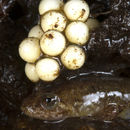Description
provided by AmphibiaWeb articles
This species of salamander is can reach up to 45 mm SVL in adult females and 55 mm SVL in adult males. The tail is slightly triangular at its tip. D. santeetlah is usually yellow or greenish along its dorsal region, with the yellow coloration more intense along the ventrolateral area and at the base of the tail. The ventral region may have melanophores and iridophores, producing a mottled appearance among many individuals (Tilley S.G. 2000).
- Powell, W. S. (1968). The North Carolina Gazetteer. University of North Carolina Press, Chapel Hill.
- Tilley, S. G. (1981). ''A new species of Desmognathus (Amphibia: Caudata: Plethodontidae) from the southern Appalachian Mountains.'' Occassional Papers of the Museusm of Zoology University of Michigan, (695), 1-23.
- Tilley, S. G. (2000). ''Desmognathus santeetlah.'' Catalogue of American Amphibians and Reptiles. Society for the Study of Amphibians and Reptiles, 703.1-703.3.
Distribution and Habitat
provided by AmphibiaWeb articles
Country Distribution from AmphibiaWeb: United StatesDesmognathus santeetlah has only been found in the Unicoi, Cheoah, Great Smoky, and Great Balsam mountain ranges in the southwest of Blue Ridge Physiographic Province of North Carolina and Tennessee. Although the range of this species is probably far wider than has been recorded, D. santeetlah is known to occur as far along the Great Balsam Mountains and Pisgah Ledge as Pigeon Gap in Haywood-Transylvania County, North Carolina (Tilley 1981). These salamanders usually inhabit seepages and small streams above 1000 m (Tilley S.G. 2000).
Life History, Abundance, Activity, and Special Behaviors
provided by AmphibiaWeb articles
Etymology:Santeetlah refers to the geographical features near the type locality of the salamanders, the Unicoi Mountains. These features are Lake Santeetlah, Santeetlah Gap, and the Big Santeetlah and Little Santeetlah creeks. This word is thought to mean "blue water" in Cherokee (Powell 1968).
Santeetlah dusky salamander: Brief Summary
provided by wikipedia EN
The Santeetlah dusky salamander (Desmognathus santeetlah) is a species of salamander in the family Plethodontidae. It is endemic to the United States.
Its natural habitats are rivers, intermittent rivers, and freshwater springs. It is threatened by habitat loss.
- license
- cc-by-sa-3.0
- copyright
- Wikipedia authors and editors

